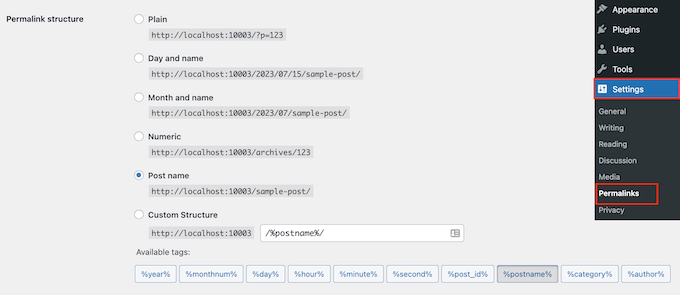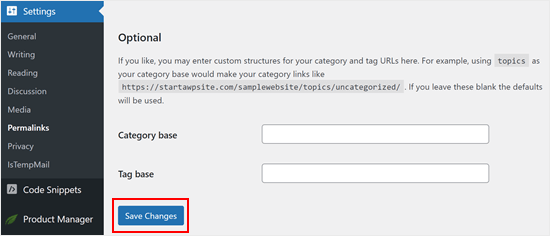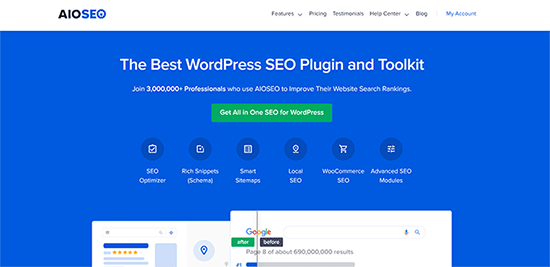Fragen Sie sich, was die SEO-freundlichste URL-Struktur in WordPress ist?
Bei WPBeginner bekommen wir diese Frage oft gestellt. Viele Nutzer wollen sicherstellen, dass ihre URLs für Suchmaschinen optimiert sind, aber sie sind sich nicht sicher, welche Permalink-Struktur (permanenter Link) für ihre Bedürfnisse am besten geeignet ist.
In diesem Artikel erklären wir, was die SEO-freundlichste URL-Struktur ist und wie Sie Ihre Permalinks in WordPress ändern können.

Was sind SEO-freundliche URLs?
Bei der Suchmaschinenoptimierung (SEO) enthalten SEO-freundliche URLs Schlüsselwörter, die einen Überblick über den Inhalt der Webseite geben. Sie sind beschreibend und sowohl für Menschen als auch für Suchmaschinen-Bots leicht zu lesen.
Hier ist ein Beispiel für eine SEO-freundliche URL für einen Blogbeitrag über die Installation von WordPress:
1 | https://www.example.com/how-to-install-wordpress |
Und hier sehen Sie, wie eine nicht SEO-freundliche URL aussieht:
1 | http://www.example.com/?p=10467 |
Worin besteht also der Unterschied zwischen den beiden? Hier ist eine Erklärung:
- Die SEO-freundliche URL enthält das Ziel-Keyword des Artikels oder die Suchanfrage, für die der Inhalt ranken soll.
- Er verwendet Bindestriche oder Bindestriche zur Trennung der Wörter und keine anderen Sonderzeichen, wie Unterstriche.
- Sie verwendet HTTPS anstelle von HTTP und zeigt damit an, dass die Website ein SSL-Zertifikat zum Schutz der Benutzerdaten verwendet.
- Der Slug der URL, der die Webseite identifiziert, kommt direkt nach dem Domainnamen, ohne zusätzliche Wörter oder Zahlen dazwischen (wie https://www.example.com/category/2023/how-to-install-wordpre
ss).
Die URL-Strukturen von Webseiten sind zwar kein wichtiger Ranking-Faktor, aber ein wichtiger technischer SEO-Aspekt, für den es sich zu optimieren lohnt.
Denn sie helfen den Suchmaschinen zu verstehen, worum es auf den Seiten geht. Außerdem tragen sie dazu bei, die Benutzerfreundlichkeit zu verbessern. Mit einer lesbaren URL können sich die Nutzer eine Vorstellung davon machen, was sie auf der Seite oder im Beitrag finden.
Was ist die beste Permalink-Struktur für WordPress SEO?
In WordPress werden die Links als Permalinks (kurz für permanente Links) bezeichnet. Sie werden sehen, dass die Begriffe Permalink-Struktur und URL-Struktur austauschbar verwendet werden.
Standardmäßig verwendet WordPress jetzt die Permalink-Struktur des Beitragsnamens in der URL, wie https://www.example.com/how-to-install-wordpress. Dies ist bereits die SEO-freundlichste URL-Struktur.
Obwohl WordPress bereits eine SEO-freundliche Struktur verwendet, fragen uns immer noch viele Leute, was die beste Struktur ist.
Sie fragen sich, ob sie ihre alte, nicht SEO-freundliche URL-Struktur ändern sollten, obwohl sie ihre Website schon eine Weile betreiben. In der Vergangenheit hat WordPress das Permalink-Format für Beitragsnamen verwendet, aber das wurde in WordPress 4.2 geändert.
Oder sie haben viele Inhalte und wollen wissen, ob die Struktur des Beitragsnamens für sie richtig ist.
Um Ihnen zu helfen, werden wir zunächst die erste Frage beantworten.
Sollten Sie Ihre alte URL-Struktur durch eine neue ersetzen?
Wenn Ihre Website seit mehr als 6 Monaten besteht, ändern Sie bitte nicht Ihre Permalink-Struktur. Sie müssen sogar nicht die Struktur der Beitragsnamen verwenden, die wir Ihnen gerade gezeigt haben.
Eine Ausnahme von dieser Regel ist, wenn Ihre aktuelle URL-Struktur aus einfachen Permalinks besteht. Wir empfehlen dringend, sie in Post-Namen oder andere lesbare Formate umzuwandeln, um die Suchmaschinenoptimierung zu verbessern.
Wenn Sie eine etablierte Website haben und die Permalink-Struktur ändern möchten, sollten Sie sich der möglichen Probleme bewusst sein, z. B:
- Verlust Ihrer bestehenden Suchmaschinenplatzierungen.
- Sie machen Ihre internen Links und Backlinks kaputt.
- Sie verlieren alle Ihre Anteile in den sozialen Medien.
Deshalb empfehlen wir, einen Fachmann zu beauftragen, der die richtigen Weiterleitungen einrichtet. Auf diese Weise werden die Nutzer automatisch zur neuen URL der Webseite weitergeleitet, nachdem Sie die Permalink-Struktur geändert haben.
Profi-Tipp: Sie möchten die Suchmaschinenoptimierung Ihrer WordPress Website verbessern, ohne sich um die Technik kümmern zu müssen? Überspringen Sie den Aufwand und lassen Sie unsere WordPress SEO-Experten Ihre Website optimieren, von der Erstellung der Inhalte bis zur technischen SEO.
Wie man eine SEO-freundliche Permalink-Struktur einrichtet
Wenn Sie eine neue WordPress-Website haben und eine SEO-freundliche URL-Struktur einrichten möchten, gehen Sie folgendermaßen vor.
Als Erstes müssen Sie in Ihrem WordPress-Administrationsbereich zu Einstellungen “ Permalinks gehen. Dies führt Sie zu einer Seite, die wie folgt aussieht:

Wie Sie sehen können, gibt es mehrere Permalink-Strukturen, die zur Auswahl stehen.
- Plain (https://www.wpbeginner.com/de/?p=123) – Dies war früher die Standard-URL-Struktur von WordPress und ist keine SEO-freundliche Option.
- Tag und Name (https://www.wpbeginner.com/de/2016/01/22/sample-post/) – Diese Option ist etwas SEO-freundlich, da sie den Namen des Beitrags enthält. Bei Datumsangaben wird die URL jedoch zu lang. Noch wichtiger ist, dass Ihr Inhalt nach einiger Zeit veraltet aussehen kann.
- Monat und Name (https://www.wpbeginner.com/de/2016/01/sample-post/) – Wie bei der vorherigen Option besteht auch bei diesem Format die Gefahr, dass es veraltet ist. Wenn es sich jedoch um eine Nachrichtenpublikation handelt, sind Datumsangaben in Ordnung, da sie zeigen können, wann der Artikel veröffentlicht wurde.
- Numerisch (https://www.wpbeginner.com/de/archives/123) – Dies ist ähnlich wie einfach, außer dass es die Archivseite und die Beitrags-ID enthält. Wir empfehlen auch diese Option nicht.
- Beitragsname (https://www.wpbeginner.com/de/sample-post/) – Diese Option ist die SEO-freundlichste, da sie beschreibend und kurz ist. Sie eignet sich daher perfekt für Unternehmenswebsites, die immer wiederkehrende Inhalte veröffentlichen, die immer auf den Ergebnisseiten der Suchmaschinen (SERPs) ranken.
- Benutzerdefinierte Struktur – Mit dieser Option können Sie Ihre eigene URL-Struktur unter Verwendung der verfügbaren Tags wählen. Wir empfehlen diese Option, wenn Sie eine größere Veröffentlichung betreiben, aber der Name des Beitrags nicht benutzerfreundlich genug ist.
Sobald Sie eine Permalink-Struktur ausgewählt haben, scrollen Sie nach unten und klicken Sie auf “Änderungen speichern”.
WordPress wird dann automatisch die .htaccess-Datei Ihrer Website aktualisieren, und Ihre Website wird sofort die neue URL-Struktur verwenden.

Wie man eine benutzerdefinierte URL-Struktur in WordPress erstellt
Bei WPBeginner verwenden wir eine benutzerdefinierte Permalink-Struktur, die einen Kategorienamen zusammen mit dem Namen des Beitrags in die URL einfügt.
Da unsere Website sehr umfangreich ist und Tausende von Artikeln enthält, passt sie sehr gut zu uns. Sie werden sehen, dass größere Publikationen und eCommerce-Shops mit vielen Produktkategorien eine ähnliche URL-Struktur haben.
Um eine benutzerdefinierte URL-Struktur zu verwenden, müssen Sie spezielle Tags in das Feld für die benutzerdefinierte Struktur einfügen. Wir verwenden zum Beispiel:
1 | /%category%/%postname%/ |
Beachten Sie, wie jedes Tag zwischen Prozentzeichen eingeschlossen ist. Beachten Sie auch die abschließenden Schrägstriche / vor, nach und zwischen den Tags.
Dieses Format ist für uns am besten geeignet, weil es den Inhalt beschreibt und zeigt, zu welcher Kategorie er gehört, ohne zu lang zu sein.
Es gibt aber auch viele andere Kombinationen, die Sie mit Tags erstellen können. Hier finden Sie eine Liste von Tags, mit denen Sie Ihre eigene benutzerdefinierte URL-Struktur erstellen können:
- %year% – Das Jahr des Beitrags in vier Ziffern, z. B. 2016.
- %monthnum% – Monatsnummer des Jahres, wie 05.
- %day% – Tag des Monats, z.B. 28.
- %hour% – Stunde des Tages, z. B. 15 (für 15 Uhr).
- %minute% – Minute der Stunde, wie 43.
- %Sekunde% – Sekunde der Minute, wie 33.
- %postname% – Eine bereinigte Version des Titels des Beitrags. Wenn Ihr Beitragstitel zum Beispiel “Das ist ein toller Beitrag! Er würde in der URL zu this-is-a-great-post.
- %post_id% – Die eindeutige ID # des Beitrags.
- %category% – Eine bereinigte Version des Kategorienamens. Wenn der Name der Kategorie beispielsweise “WordPress Tutorials” lautet, wird er in der URL zu “wordpress-tutorials”. Verschachtelte Unterkategorien erscheinen als verschachtelte Verzeichnisse in der URI.
- %author% – Eine bereinigte Version des Autorennamens.
Sobald Sie Ihre benutzerdefinierte Permalink-Struktur eingerichtet haben, vergessen Sie nicht, wie zuvor auf die Schaltfläche “Änderungen speichern” zu klicken.
Bonus-Tipp: Verbessern Sie Ihr WordPress SEO mit All in One SEO
Nachdem Sie nun eine SEO-freundliche URL-Struktur eingerichtet haben, sind Sie wahrscheinlich auf der Suche nach weiteren Tipps zur Verbesserung des SEO-Rankings Ihrer Website.
Wir empfehlen die Verwendung des All in One SEO (AIOSEO) Plugins. Es ist das beste WordPress-SEO-Plugin, das von mehr als 3 Millionen Websites verwendet wird, und dies ist das Tool, das wir auf WPBeginner verwenden.

Es verfügt über alle leistungsstarken SEO-Funktionen, die Sie benötigen, wie Sitemaps, Schema-Generator, Umleitungsmanager, Link-Assistent, On-Page-SEO-Analyse und vieles mehr, um Ihre SEO-Rankings zu verbessern.
Weitere Einzelheiten finden Sie in unserer Anleitung zur richtigen Einrichtung von AIOSEO und in unserem ausführlichen AIOSEO-Test.
Darüber hinaus können auch die folgenden Leitfäden hilfreich sein:
- Ultimativer WordPress SEO-Leitfaden für Anfänger
- WordPress SEO Checkliste für Anfänger
- Wie man ein SEO-Audit in WordPress durchführt
- Wie man das ultimative SEO-Dashboard in WordPress hinzufügt
Wir hoffen, dass dieser Artikel Ihnen geholfen hat, eine SEO-freundliche URL-Struktur für Ihre WordPress-Website zu erstellen. Vielleicht interessieren Sie sich auch für unseren Leitfaden zu Kategorien und Tags: SEO Best Practices für die Sortierung Ihrer Inhalte und WordPress-Site-Einstellungen, die für den SEO-Erfolg entscheidend sind.
Wenn Ihnen dieser Artikel gefallen hat, dann abonnieren Sie bitte unseren YouTube-Kanal für WordPress-Videotutorials. Sie können uns auch auf Twitter und Facebook finden.





Iriogbe peter
Keynotes from this post and what Google recommended
Google suggests keeping your website addresses simple and easy to understand. When creating a URL:
Using hyphens or dashes (-) is preferred over underscores or other symbols. For instance, go for “my-page” instead of “my_page.”
It’s a good idea to keep things straightforward. Don’t add unnecessary details or extra information to your URLs. Focus on using keywords that accurately describe your content.
If you can, try not to include dates in your URLs unless it’s really important for what your content is about.
Moinuddin Waheed
Earlier I used to have the default options for Permalink structure that was with the WordPress installation.
I have them switched to use the posts slug for Permalink structure as it looks good and seo friendly as well.
Having said this having both category and then posts is very good as it helps categories the posts.
I will do this custom permalink structure for my posts.
Thanks for this helpful guide.
Reza
Hi,
Thank you for your short and informative article. just a quick question?
Our website has been running for more than a year. I checked the permalink and it is set to Day and Name.
what do you think if I change it to Post name?
Thanks
WPBeginner Support
If you decide to change your permalinks then we would recommend taking a look at our guide on creating redirects below to prevent any issues.
https://www.wpbeginner.com/beginners-guide/beginners-guide-to-creating-redirects-in-wordpress/
Admin
Nicola
This is simply the best article I’ve ever read on the topic!!!
WPBeginner Support
Glad you found our article helpful!
Admin
Julia
Hi, thanks for the article, it’s really complete and helpful. Could you please provide examples of plain links?
WPBeginner Support
For plain links, we cover that in the permalinks setting section or you can take a look under Settings, Permalinks to see what plain permalinks would look like for your domain
Admin
Etinosa
I’ve had my blog for almost a year and the permalinks I use is the month, day then post title one. I would like to change it to just the post title.
How do I go about this? I don’t want to end up with broken links.
Do you think I should change it or I should just leave it as it is?
WPBeginner Support
It would be a difficult process to change your permalinks after a year, there are tools on the Yoast site for what to add to your htaccess for redirects or you can keep your permalinks as they are.
Admin
Ute Rehill
Thanks for this. I find all your articles very helpful!
Dwayne S
I have seen where when a post is created it removes words like in, for, at etc. Yoast warns about leaving these words (stop words I believe they are referred to as) in the url. However I notice all your blog posts utilize these stop words. Can you explain why you don’t remove stop words from your urls?
WPBeginner Support
Hi Dwayne,
We believe that this way URLs are more readable and understandable by both human users and search engines.
Admin
Ravi Kumar
Yes, I agreed on this too.
Teresa Solomita
Hey, thanks for this article! My site was launched this week by a developer and now I am learning WP! I changed my permalink setting to post name – they had it as Day and Name!
Gideon
Thanks for the information, I will have to change my permalink since my site is just 3 months old.
SANJEEV KUMAR
Sir,
I used custom structure with post name. The main is comes when i change the post permalink the the post permalink is updated in desktop and working fine but in mobile the permalink not updated and gives 404 error.I used news paper please helped me in this matter.
AKulkarni
Thanks for this nice write-up.
I have one question and if you could advise, that would be grateful.
I have a WordPress website (not launched yet, testing phase). Registered users can submit post and comments. I am using ‘Post name’ as permalink structure. Issue arises when user changes the post title, the permalink also changes which from SEO point of view will have broken links in search if already indexed. I understand i can switch to ‘Plain’ permalink (Post Id) structure. But I want to utilize URL keywords from SEO point if view.
Is there any to achieve this by using custom permalink structure or only way is to use Plain permalink structure.
Smith R.
1) From Permalink settings in WordPress, I had added “.” (dot) in Category base so now my category URLs are like: example.com/smith instead of example.com/category/smith
Although, you try to enter example.com/category/smith, it will redirect to example.com/smith
2) Now, I have created some pages with the same name as a category, URLs for both are same. Is it bad for SEO?
for example:
parent Category is: example.com/smith
sub-category is: example.com/smith/rr
parent page is: example.com/smith
child page is: example.com/smith/rr
I don’t know what’s going on in backend and how it can affect SEO?
Thanks in Advance.
Trish
Hi there,
help please
can someone tell me how using the permalink custom structure tag %slug% works?
How, if at all, is it different to using the structure tag %postname%
thank you, Trish
Alex Zamora
Hi there: For about two years I had my blog hosted on a wp.com page. One week ago I finally decided to transfer it to a .org domain. That said, do you consider I should change the structure on my permalinks to a more SEO friendly one? I mean, you recomend no to do it if the site was older than 6 months, but I’m not sure if that applies for my recently transfered site. Thanks, guys. Cheers.
Gurjit singh
Please advice is this SEO Friendly
/%category%/%postname%.html/
Gurjit Singh
Thanks you so much.
Elizabeth
How do I make it so the structure would be /blog/category/post-name?
I can’t figure out how to get /blog/ before the category.
Thank you!!
Amit Biswas
Hello,
How to include the sub category base in the URL, I mean
Website,com/category/subcategory/post
Please help me out. Please make a video tut.
Thanks a lot
Amit Biswas
WPBeginner Support
Hi Amit,
Please take a look at our tutorial on how to change the category base prefix in WordPress.
Admin
Naomi Trevino
I’m a new blogger and I’ve always changed my URL. Am I not suppose to and just let it be the default? I have a new WP version so it picks up something just I thought I had to change it every time instead of leaving it how it was.
WPBeginner Support
Hello Naomi,
Yes, you are not supposed to change it once you are happy with a URL structure.
Admin
Louise Hake
Awesome post.
Swapan Kumar Manna
Hello,
Very good information and nicely touched down every single aspect. I own a News Site hosted on WordPress and using /%category%/%postname%/ in the URL structure. And I want to migrate it to Day and name (/2016/01/22/sample-post/) since I read some articles that states it will increase server up-time speed. I’ve more than 250 posts on the website and older than one year is it a good idea to change the Permalink parameter?
Bala murali
Hello how to include the sub category base in the url, I mean
blog/category/subcategory/post
please help me to find the solution for this
juli
Hi! This is great, thank you! How can I change my post structure on only the posts going forward? I don’t want to change any of the posts in the past, as I’ve been blogging for 5+ years now and I don’t want to loose any of that SEO. Currently I have the post date listed first, but I want to change that to just be the post name as the perma link for both my blog posts and my gallery.
Thank you!
Smriti
I have been using wordpres for over 6 months now and every time I tried changing my permalink structure from plain to /%category%/%postname%/ I get a 404 error. I hit the “Save Changes” but to not use. can you please tell me what i should do? Thank You!
WPBeginner Support
Try to backup and delete your .htaccess file. Then visit the permalinks page and click on save changes. Refresh your FTP client to confirm that WordPress has generated a new .htaccess file. This should resolve your issue.
Admin
Nancy
I am getting ready to move my site from wordpress.com to wordpress.org. I have about 200 posts on my wordpress.com site. I would like to change my permalink structure on my wordpress.org site to post name. I plan to use wordpress.com’s $13 a year site redirect. Will I have problems with broken links?
WPBeginner Support
From WordPress.com support:
Admin
Berk Onal
I have changed permalink of my product page.
Now i have an error message of “Duplicate meta descriptions” showing the old permalink and new permalink as duplicate.
How to solve this problem.
Andy
What is considered best practice (SEO wise) for internal linking? IE. Using Woocommerce I have links in my product descriptions to options that we offer. I can use the /descriptive-link/ or the /?p=321. Intuition tells me the first is better for SEO but the programing part of my brain says the latter is “safer”
WPBeginner Support
Descriptive links or pretty permalinks are more SEO friendly and safer as well.
Admin
Jackson
This is a great article and its easily explained in layman’s terms. I have one issue that I cannot find a solution to and others may have encountered the same issue. The problem with my blog is that trashed pages. If I have a trashed page, how would I reinstate it without having to change the custom structure to the plain structure? I’ve basically ruined a blog with over one hundred and fifty pages grhhhhhhhhhhh! Any help would be appreciated please
WPBeginner Support
Simply go to Pages and then click on trash. Take your mouse over to the page you want to restore and click on the restore link. If you want the page to not have the URL that it previously had then you can copy its contents and paste them into a new page. Publish the new page and delete the old page.
Admin
Nisha
Great article. I am in a fix now. I have a running site which is around 10 yrs old. Unfortunately my post urls have date in it.
But it’s better late than never.
If I opt now to have my permalink in new post structure, as you said, the older posts will also get changed.
What is the best solution to do it. I can’t afford to hire somebody to do it manually. I can try my hands though.
Is there any plugin or tool which will make my job easy?
I am expecting a response from the readers as well, who have tried it first hand.
Umer
I am running following site. but its traffic is not consistant. i am sending you my site link. Please suggest me how i can gain more and consistent traffic and also tell me about my mistakes. Pleasae.
WPBeginner Support
See these tips to drive traffic to your new WordPress site.
Admin
Merry Clerk
This is very nice post thanks for sharing this blog about permalinks.
Shah Jahan
Hello,
I am using the redirect tool by yoast to redirect my old permalink structure to the new one, it works fine, but the wordpress admin panel not working, giving me the 404 error.
Also the child category posts are also not working. Please guide.
My old permalink structure was /%category%/%postname%.php
And the new one is /%postname%/
Thanks,
Gail Palubiak
Thank you for your article, it was very timely. I love WP-beginner!
However, it still seems a bit over my head. I wish you included more examples. I’m in the process of putting the finishing touches on my website (pure DIY). I haven’t even started blogging on the site so I have been more concerned with how to get . Although I have no idea why %postname% worked but it did so I’m thrilled (%postname% just doesn’t seem to correctly call out the page I want). Anyway, I still don’t have a clue what is meant by “categories”. I appreciate the link you shared, however, it’s still written beyond my pay grade. It says in the article, “WordPress comes with the ability to sort your content into categories, tags, and taxonomies.” It never explains WHY this is useful. Would you mind sharing a bit more on categories from a user point of view please?
Avdesh
Hi, I recently moved my blog from BlogSpot sub-domain to my custom domain on WordPress. After reading through the stuff available online, I chose the ‘Month and Name’ permalink in the WordPress as its being mentioned that this is most similar to what BlogSpot uses and if one is transferring from BlogSpot to WordPress, then one should chose this permalink only in order to loose existing traffic and Google Page Ranking. Now, after reading your article above, it seems that the best permalink would be “Postname’ permalink. Can you please guide me whether I should change my permalink to ‘Postname’ or should I keep it to ‘Month and Name’ permalink?
Toublanc
Hi, this is a very good post about permalinks, thank you.
I have a question about it, is it possible to use regex to dynamicaly rewrite category name in the URL?
Jean-Pierre
Hello! I use custom /%category%/%postname%/ . The categories are English and Farsi (using Arabic characters). The permalink in sitemap for farsi turns to:
/farsi/sms-%d8%a7%d8%b3-%d8%a7%d9%85-%d8%a7%d8%b3/
This is not helpful for SEO. Can you help please? thanks.
assem foad
same problem here with arabic , how to solve and can it affect seo or not?
Chuks Guide
Great post. I was using custom pemalinks structure just like u mentioned earlier on my site but when i changed to post name permalink i lost my previous links i shared on social media pages which resulted to error 404.
You just made me understood why.
mohamed salad omar
how to change post categorie number want only one categories dispalyed in website feated
Jamshaid Ali
Useful Content for the beginners. I also got some new tips from here. Thanks for sharing.
Gerardo
Hi, i have a question about the permalink structure:
Before to use wp.org i had used wp.com with date+name of post (by default).
Now on wp.org i try to use only the name, but the social link not working, so to fix i have setting post id+name to have a post name and a little numbers before.
Do you think it a good idea? Because all permalink working fine, just only name not working, so i think used id+name could be a good idea
Thanks
Richa Kamal
Hello! I had a question regarding custom tags. What if I have to use same or similar title, e.g. for outfit post? Is it a good idea to add a numeric value to the URLs as well. I am skeptical about using %post_id% as it will be sequential then and can make some other posts seem out-of-date. How about adding a random number to the URL like tumblr posts. How can we configure it to be part of URL just like categories?
Dan Awontis
Nicely written. I was absolutely able to understand and follow everything, and to lear, which is the most important thing.